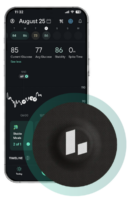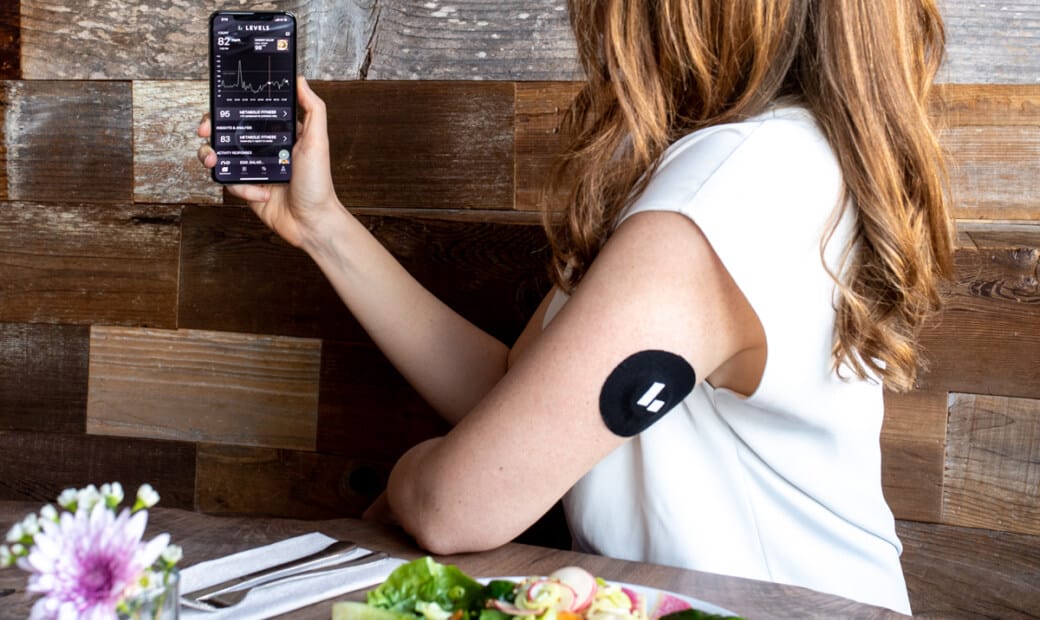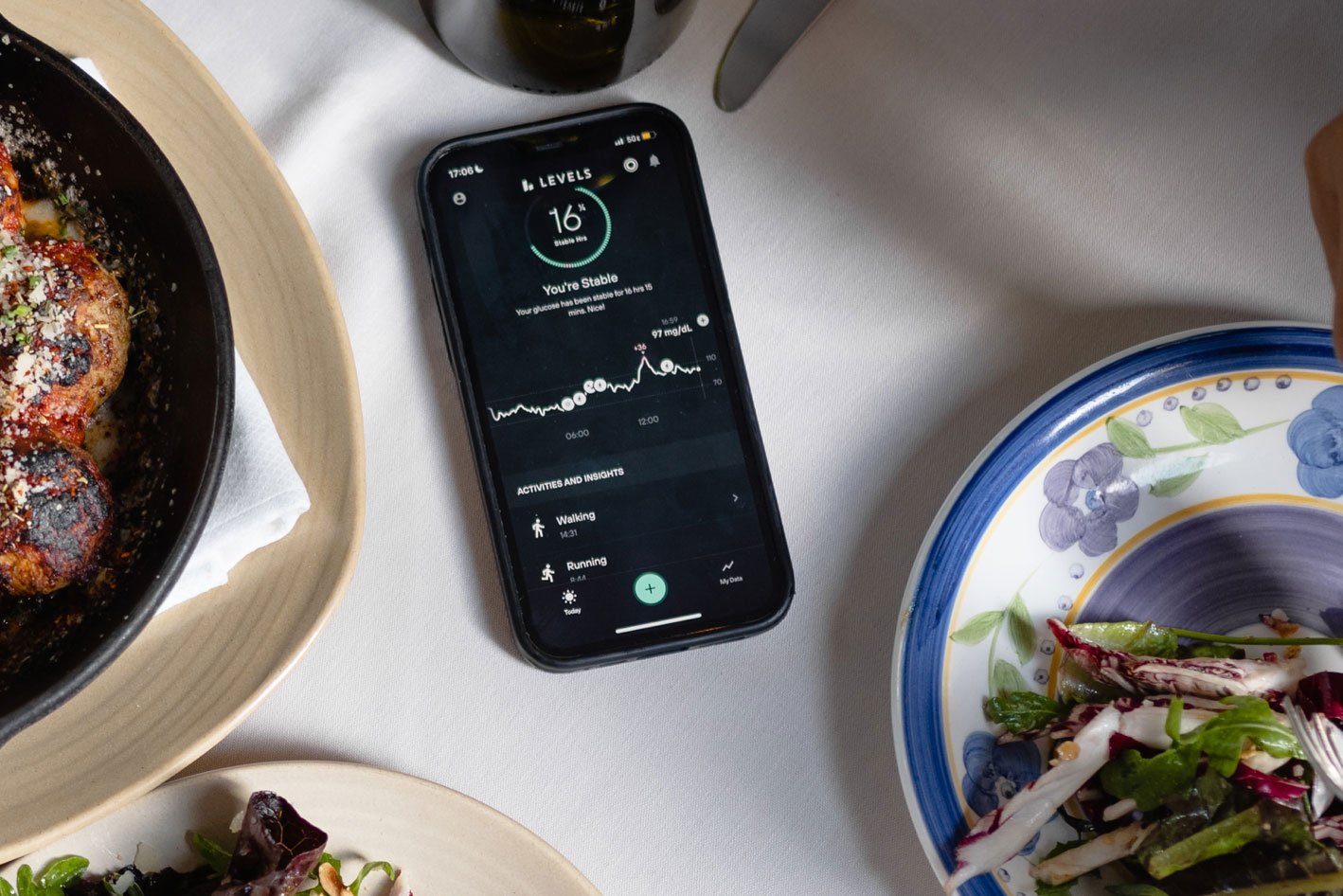If you’re using continuous glucose monitors (CGMs) to improve metabolic health for any length of time, you’ve likely had the experience of putting on a new sensor and suddenly seeing higher blood glucose readings for no apparent reason. If you then compare the data to a finger-stick test, you may see an even more considerable discrepancy. It’s natural to wonder about the accuracy of CGMs: How can you trust the device to guide your food choices if it’s not perfectly accurate?
It’s important to remember that CGM devices are still manufactured first and foremost for diabetes management, where glucose readings can be significantly higher than a general population, and exacting precision is less critical. However, the good news for people using continuous blood glucose monitoring for general health and wellness is that the devices don’t need precise accuracy to be helpful.
The main focus is not the exact glucose number but the trends in your glucose values over time in relation to meals, exercise, sleep, and stress, even if baseline readings are slightly different. In other words, the overall shape of your glucose curve—the steep spikes, the gentle hills, the crash—paints a picture of how a given food affects your metabolic health.
CGM accuracy between sensors and brands
A 2022 study from King’s College London provides strong evidence that modern CGMs are reliable enough to differentiate the glycemic response to different meals. The researchers outfitted 394 people without diabetes with two CGMs at a time, either two of the same brand (Abbott’s Freestyle Libre) or one Freestyle Libre and one Dexcom G6. The goal was to see how well the CGM readings from the devices agreed with each other.
The results were encouraging. Agreement of glucose data between two Freestyle Libres was quite strong for standardized meals, where each participant ate the same breakfast and lunch on two separate days. While there was more difference between the Freestyle Libre and the Dexcom, it was still much better than a smaller 2020 study that used older devices and cast doubt on CGM reliability.
Interestingly, there was a bigger difference in the reported blood glucose levels when the same CGM measured the same meal eaten on different days than when two different CGMs measured the same meal simultaneously. What does this mean? The variability between CGM sensors is less than the natural variability in how your body responds to a meal. This isn’t shocking given all the factors that can influence your response, from sleep to exercise to timing and more. (There have been significant advancements in the field: The latest generation of blood glucose meters—the Abbott Freestyle Libre 3 and the Dexcom G7, both available to Levels members—are also more accurate than their predecessors.)
In other words, even if the precise glucose measurements differ between CGM brands, the devices can still compare the glucose response of, say, a bowl of sugary cereal and a plate of eggs and avocado. And it’s those relative responses that matter for using a CGM to inform your food choices.
How to use CGM despite its variation
While seeing those CGM values jump around may be unsettling, don’t let that undermine your progress toward better metabolic health. The real value of CGM for a person without diabetes is to identify how different meals and lifestyle choices affect your blood sugar levels—and you don’t need perfect accuracy to reap those insights.
What you’re looking for are the overall trends. Do your glucose levels remain relatively flat and stable after eating a particular food, or do they take you on a roller coaster of steep spikes and crashes? (The degree to which glucose levels rise and fall throughout the day is called glycemic variability.) Do certain meals combined with an after-dinner walk lead to a gentler curve than those same meals eaten before sitting on the couch?
Focus on the big picture, not the precise digits, and you can learn valuable lessons about achieving optimal metabolic health. You may discover, for instance, that even “healthy” foods like grapes and oatmeal cause big spikes that take a long time to come down without some protein or fat to blunt the rise. Over time, those spikes can lead to metabolic dysfunction, insulin resistance, and an increased risk of chronic diseases like Type 2 diabetes. But you’d never know without the real-time feedback of CGM.
It’s also important not to forget the forest for the trees: The key to living a long, healthy life is rooted in some core basics: eat healthy, sleep enough, move every day, reduce stress. CGM is one data source that helps you hone in on the diet part, but consistently striving for all four pillars is what’s important. The Levels app can help you expand your view beyond the basic glucose values through Habit Loops and long-term trends.
How do CGM devices work?
CGMs contain a thin filament that, when inserted, reaches the interstitial fluid beneath the skin. Most people insert CGMs on a fleshy part of the body, like the upper arm, that’s less likely to be bumped or irritated. The filament measures the glucose that seeps from the body’s blood vessels and capillaries, and into this interstitial fluid. Therefore, CGMs technically measure interstitial glucose, rather than blood glucose. But the former is a good predictor of the latter, even if there is a bit of lag time. (And some people still use a finger-prick test, drawing a small blood sample, to calibrate their device.)
A series of chemical reactions generates a current that is then transmitted to the CGM system—either a hand-held glucometer or an app like Levels. From there, an algorithm generates a glucose reading from the current.
Conclusion
By focusing on your individual responses to meals and lifestyle factors instead of getting hung up on specific numbers or the exactness with which glucometers measure glucose, you can harness your CGM data to make meaningful improvements in your metabolic health—without the need for perfect precision.
 Interested in using a CGM?
Interested in using a CGM?
The best way to understand how well your body processes your diet and lifestyle choices is with a continuous glucose monitor and an app like Levels to help you interpret the data. Levels members get access to the most advanced CGMs and personalized guidance to build healthy, sustainable habits. Click here to learn more about Levels.

 Interested in using a CGM?
Interested in using a CGM?






